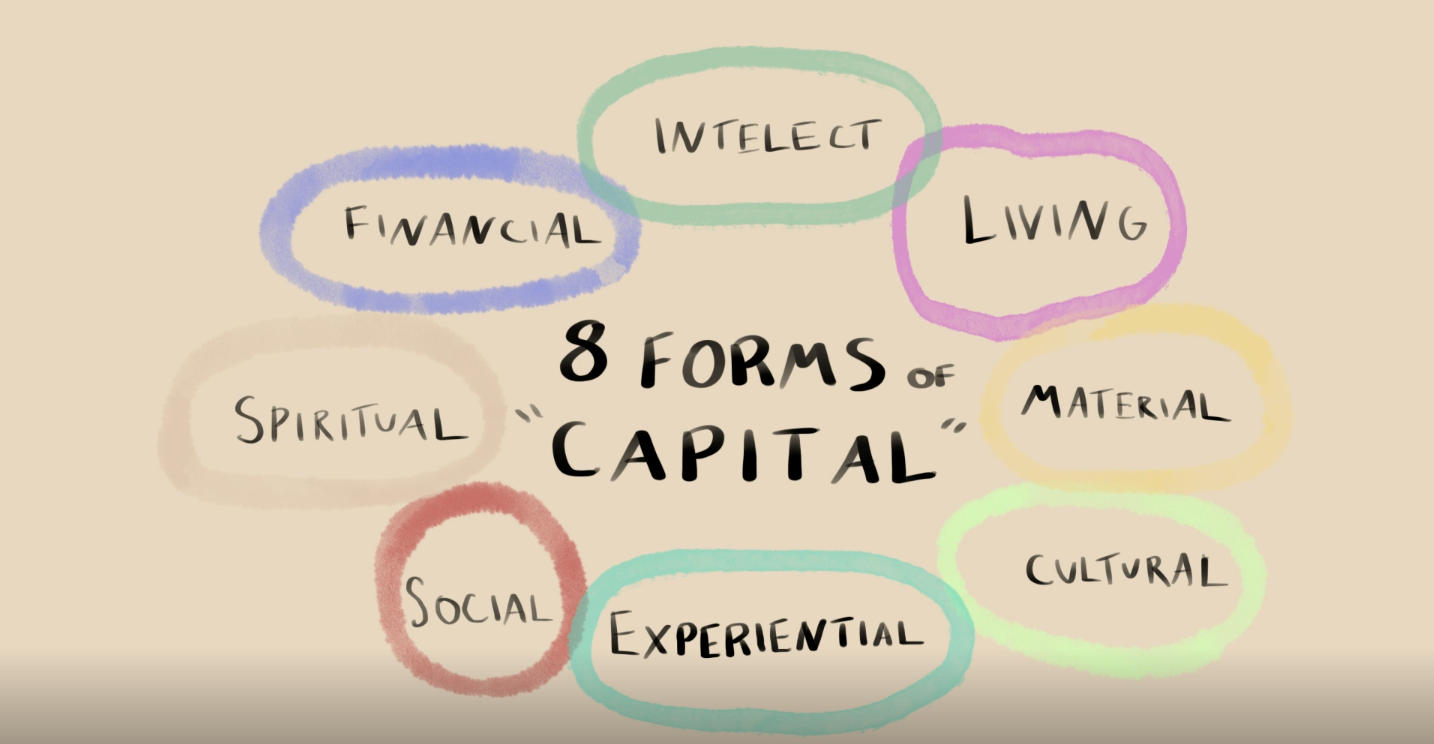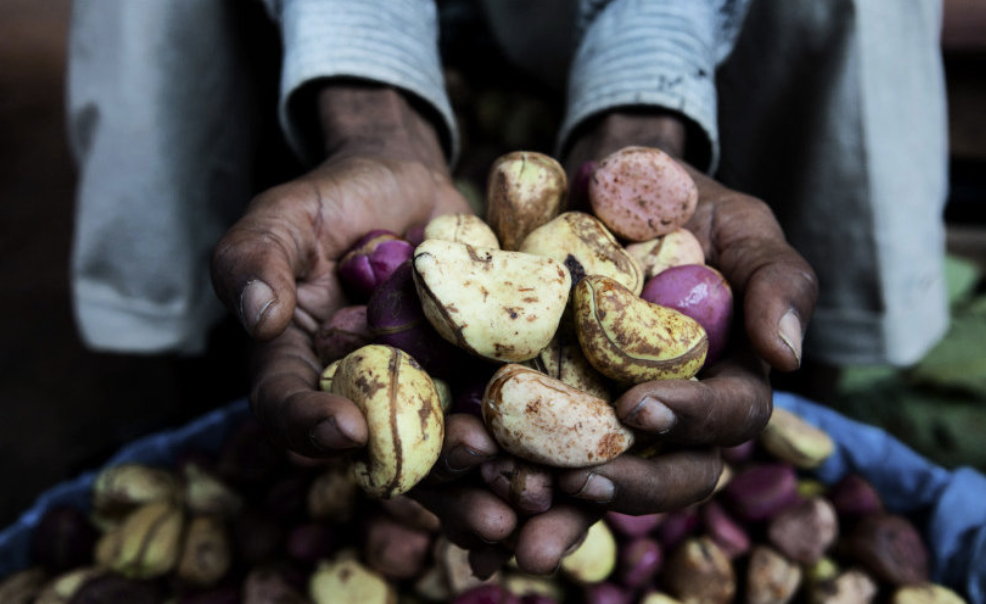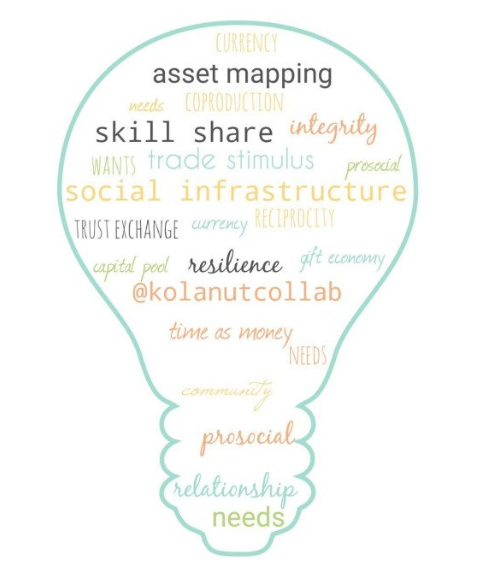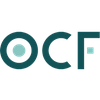Inspiration behind the development of the Kola Nut Collaborative

This interview with OCF Program Director was created by Artist-Organizer Fellow Ebony Gustave with Mike Strode, a Program Director at Open Collective Foundation.
The Kola Nut Collaborative is a mutual support network created by Mike Strode to engage people in reciprocal exchange of services, skills, and goods through a time bank - where the currency is an hour of time for everyone.
In 2008, while on the parent council at Betty Shabazz Charter Academy, Mike was introduced to the Black Oaks Center for Sustainable and Renewable Living. He got involved with their Healthy Food Hub, an initiative to bring healthy produce and dried goods into the school among a largely vegetarian and vegan community.
As the Healthy Food Hub was looking for models to sustain the effort and expand, they considered timebanking as a way to incentivize people to participate in a meaningful and socially impactful project. Since the hub wasn’t necessarily generating a lot of financial capital, the Kola Nut Collaborative was created to fill that void.
They were also inspired by the Cowry Collective’s timebanking in St. Louis. The kola nut and the cowry shell are ancient forms of currency. The cowry was used amongst lands in Asia and the Pacific Islands, the kola nut was used in West Africa. Specifically, in Igbo culture, it's a symbol of hospitality, beneficial exchange, and trading relationships.

What are the different forms of capital, and how can they show up within timebanking?
Mike: The Appleseed Permaculture model talks about financial, intellectual, living, material, cultural, experiential, social, and spiritual capital. Money is one-eighth of that, it’s only one part of what all our communities have to offer. I often talk about timebanking as seven-eights of that.
- Intellectual Capital: Giving ideas
- Living Capital: Offering your presence as a form of care
- Material Capital: Space in exchange for labor
- Cultural Capital: Language lessons
- Experiential Capital: Learning carpentry
- Social Capital: Relationships we have and who we know
- Spiritual: Sharing practices and ideas around mysticism
All of these things can be represented in timebanking in a much more robust way than you can do with money.
How is the concept of value challenged through timebanking?
In timebanking one hour is worth one hour and that’s for everybody, no matter who’s hour is being shared.
If I am a lawyer, I spent my ten years going through law school, getting the bar, I did my work so I expect to be paid $100,000/hr or whatever it may be. If I am an eldercare worker, I’m paid $17/hr. The interesting thing there is eldercare insurance is sky-high but somehow people don’t get paid much. The inequity is thin and the timebank is really about people challenging that inequity in themselves. We’re coming on an egalitarian basis, by equalizing the value we’re creating a different type of playing field for people to exchange on.
How do people determine how much to exchange or give in hours?
What I tell people directly is that you cannot ask for more hours than you spent doing the thing. If someone wants to give you more hours because they really appreciate you- like if I had someone come in and organize my basement in two hours and I probably would have spent five, then I will give them the five. Don’t ask for more hours than you worked because that person has to make up those hours on their own. So the hours that they are giving you, you then have to give out five hours into the timebank, that’s how we can think about value. You can appreciate someone’s value more but you can’t ask for whatever value you think you are worth in more hours.
What is your approach to connecting people within the community to an alternative form of currency?
It takes all kinds of people to make a community, if someone didn’t cut the grass in the park, some part of my community would falter. Young people may not want to play there, and it may become overgrown. Although the money economy is valuing them below someone doing IT consultation, if that grass-cutting didn't happen, the community could fall apart.
In terms of connecting people to these visions of an alternative economy, when I started in 2017 to launch the Kola Nut Collaborative I did it wrong. I was a part of the permaculture guild that Black Oaks was launching at the time. Permaculture is a form of sustainable agriculture that really thinks about design in partnership with nature. I was teaching a social permaculture section of the course. Just as permaculture thinks of agriculture with a design ethos, social permaculture thinks about how we design our relationships and behaviors in our communities that are fulfilling, sustainable, and nourishing.
When I started pitching the idea of the timebank I was about the numbers, economy, having a slide deck that had sixty impactful slides, taking people back to the Yap islands, and talking about the gift economy with the Navajo. I thought that I had to go through the entire history of the gift economy, solidarity economy, and exchange to get people to understand the concept. What it's really about is the embodied experience.
I began to design experiences, like the monthly Time Salon where people can really have conversations about how they feel about money, how they feel about the economy, and what the economy means to them. Also, I began to pick up on models like the Offers and Needs Market pioneered by Post Growth Institute. It is like a lightning round session where people would go through and pitch something they have to offer and then people will exchange their needs.
These facilitation methods really get people into the space of realizing 'I have more gifts than I think, maybe even something that I don’t do professionally'. Someone who really likes to make candles and would never go out and sell would have the opportunity to make them if someone asked them to do it as a favor. Those are the sorts of things where you can get people thinking. There’s a way of exchanging that maybe they can do more and use that other economy less. I get people to engage by showing and reflecting to them: here are ways we are already doing it.
How does time banking build community resilience?
I’ll relate it to what happened immediately after COVID with the mutual aid organizing work. The mutual aid work started a little bit scattered and then they immediately started disseminating this model of pod mapping that has become very well known nationally as a strategy for how mutual aid groups organize themselves. The concept is simple in that you begin on your block. Mariame Kaba talks a lot about this in her interviews and writings on the subject. You begin on your block, door-knocking and connecting with neighbors. You’re weaving together amongst your neighborhood and you're building a pod right there where you are. Hopefully eventually there’s a pod on the next block in the next neighborhood and those pods would connect.
The definition of resilience is the ability of an organism to adapt or respond to change. When communities know who is in their community, what skills are in their community, what assets they have available, and can be in communication with each other around their needs, then they are more resilient when changes come.
Autumn Brown and Adrienne Maree have a podcast How to Survive the End of the World. They did an episode once about the apocalypse and Autumn made a statement that when a crisis happens, it's not about guns, butter, blue jeans, or about the things we think we need stored away to survive the crises. It's about do you know who your neighbors are, do you know what they have, their skills, their strengths, and their needs - because there could be a crisis right next door and if you don't know how to respond to that need someone could be injured or die. All of these things are about making the web stronger.
In my backyard there’s that mycelium network that's beneath the earth that connects plants and transmits resources, when there’s a change that happens in the dirt those roots know how to reroute. They have some sort of communication mechanism so they know how to reroute around that crisis. Certain plants won’t respond and some will, at all times nature is tenacious and something is going to grow where that crisis occurred. That's what I think about when I think of community resilience, having the capacity to adapt to whatever crises, whatever change comes. The timebank is really about us getting to know those assets that we have around us to respond.

What is the greatest challenge in nurturing a timebank?
It really is a challenge to sustain the ongoing momentum, sometimes it waxes and wanes. We had a really promising partnership with Hive Chicago and after that partnership ended the members that joined kind of stopped engaging. There are some other partnerships like North Park Nature Center who took on the role of developing their own timebank hub. Which means people went to their center, got oriented around what timebanking is, and they applied for membership. The director of the center would then email me, let me know they did an orientation for this person, and ask if I can activate their membership. Sometimes there are promising starts like that but just sustaining the ongoing momentum is the greatest challenge.
Cowry Collective doesn't exist anymore, the thing that was challenging was that Chinyere, who launched the collective, ran out of personal steam and capacity to hold this effort up that she had been running for about 10 years. That’s a really honest human assessment, that it takes a lot of human energy to lift up a timebank while trying to build institutional capacity and create an institution for this. There’s a great chance that it won’t happen, but hopefully you can make some connections that will continue to last, which is true of St. Louis. The people that were connected through the timebank are still connected, they still have relationships, they still exchange with each other, and they had the opportunity to embody this experience of a different economy and that lives with them.
What advice would you give to someone who wants to start a Timebank in their own community?
The first thing is to find a group and run an Offers and Needs Market. If you don’t know what an Offers and Needs Market is, the Post Growth Institute has some resources on it. Once you start an Offers and Needs Market with a group of friends or neighbors in your community, then you can figure out what’s available within the network and, the timebank is a place to put it. It’s an infrastructure where you can put these things and it's also a digital ledger where you can log the exchanges you have with each other. The first step is really to get people to feel that experience, that delight in the exchange, and sharing what they have to offer and need.
Connect with Kola Nut Collaborative:


